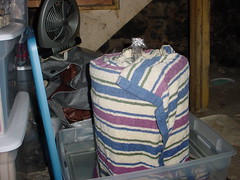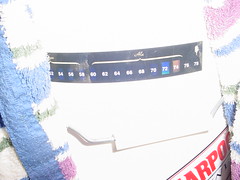One of the hardest parts about homebrewing in the summer is keeping your brew cool during the fermentation and conditioning stages. If your brew gets too warm, the yeast will produce off flavors, which can include grapefruit-like sourness and bannana flavors, and can also produce more fusel alcohols, which cause massive headaches the next morning. Usually, to combat this, homebrewers will make darker beers, with more complex flavors so that the off-flavors won’t be so noticable. However, often in the summer you will want to drink something light, like a pilsner. You probably don’t want something dark and heavy like a porter or stout on a hot summer day.
The ideal temperature depends on the yeast that you are using, but 68 – 70 degrees Farenheit is usually a good target. This can be easily accomplished if you are lucky enought to have a central air-conditioning system that keeps your house at a constant temperature. Another really great way to control the temperature is with an old refridgerator. You can modify the thermostat to keep the interior at whatever temperature you like. This is really ideal, since it even makes it possible to make lagers, which need even lower temperatures.
[ad]
However, these are luxuries that many of us do not have. Here is how I made my own cooling system, using just a plastic bin, a towel, a fan, and some water.
The principle behind this system is exactly like what your body does when you sweat.
First, find a plastic storage bin that is slightly wider than your fermentation tank. Put the bucket in the bin, and pour some water into it. Then, soak a towel in water, and wrap it around the fermentation tank.
Set up the fan so that it blows at the towel, evaporation the water on it. The evaporating water will draw heat from its surroundings, which happen to be the fermentation tank. The towel will then wick more water up from the bin below it to replace the evaporated water.
 I first read about a system like this a while ago, but never actually did it until recently. I will keep you posted on how well it works, but it seems to be doing the trick. In the past two days, since setting it up, the temperature has dropped about four degrees, and is about two degrees cooler than the ambient temperature in my basement.
I first read about a system like this a while ago, but never actually did it until recently. I will keep you posted on how well it works, but it seems to be doing the trick. In the past two days, since setting it up, the temperature has dropped about four degrees, and is about two degrees cooler than the ambient temperature in my basement.
It would probably work even better if my basement had more dry air, but, like most New England basements, it is pretty damp.
Let me know if you have tried this, or any other methods for controlling the temperature of your beer. I’d love to hear new tricks.
UPDATE:
Well, I’m ready to bottle now, and this system seems to have worked great. The only caveat I would mention is to use an old towel, because of the possibility of mold/mildew growing on it. It shouldn’t be able to get into the beer, but you probably don’t want it on your nice towels.
One Comment